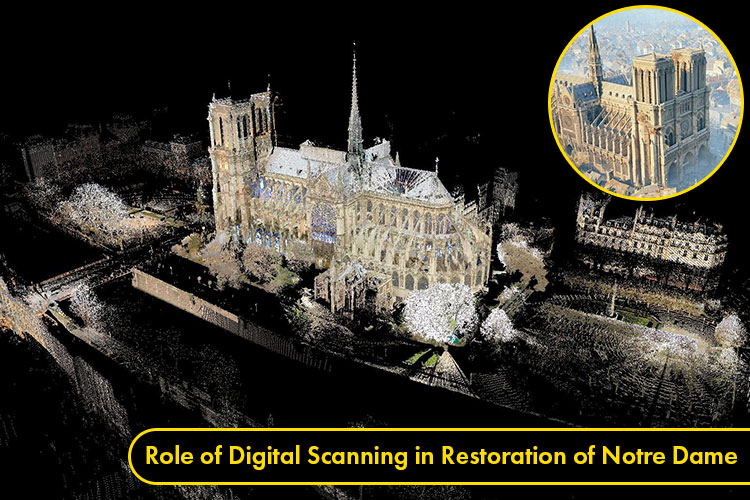Role of Digital Scanning in Restoration of Notre Dame

Notre Dame came to be when Maurice de Sully, bishop of Paris had the idea of converting the ruins of the earlier two basilicas into one singular structure. The construction began in 1163 and it took 182 years before the building was finally completed in 1345.
On April 15,2019 a fire broke out in the cathedral and spread through its largely wooden structure. This iconic Gothic monument which took years to build, survived two world wars – was destroyed in mere minutes. The comforting prospect was that France immediately vowed to rebuild the cathedral, and a donation of more than $1 billion dollars was promised towards this.
Table of Contents
In order to restore Notre Dame digital scans of the essential part of the buildings will be important. These scans are currently only with the organization named Art Graphique & Patrimoine (AGP). They will be working with historical monument contractor’s association GMH and US-software firm Autodesk. The whole project will be a massive undertaking but the architects and engineers are confident that it will be restored to its former glory with an effective combination of 3D laser Scanning and BIM especially with Architectural BIM Services.
Andrew Tallon and how he digitally scanned the Notre Dame:
One of the bigger mysteries surrounding Notre Dame was how it was constructed. Late Andrew Tallon in 2015 decided to use scanners to understand its history. Leica Geosystems laser scanner was used by Tallon in order to carry out this project. This 3D laser scanner works in a way that it sends laser strobes to measure the distance between the scanner and any point that it hits in the room. Each measurement is represented by a colored dot, and a 3D collection of these coordinates together is known a point cloud. When it comes to a larger, irregular spaces, the scanner needs to be set in different locations like in the case of Notre Dame it was 50 different locations. Once the first step is completed, the series of point clouds are uploaded from them and then the scanning software can combine it into one composite 3D point cloud model.
The scans taken by Andrew Tallon were of remarkable detail and they revealed some previously unknown characteristics of the building. For example, the scans exposed that interior column at the western end of the cathedral didn’t line up. These small revelations would have otherwise been unknown and now they will play a crucial role in reconstruction.
The trickiest part of the whole rebuilding is perhaps going to be the roof and the spire as much of it was destroyed during the fire. However, the level of detailing in the scans is accurate up to a couple of millimeters, so the architects will be able to use that to recreate measurements of the beam and overall structure.
Why does it stress the need to preventive scanning of historic buildings?
Digital Prevention is a relatively new concept in heritage and archeological buildings. With 3D scanning the structural and physical conditions of the building can be analyzed. It can also be used to examine the effect of footfall, pollution and changing weather condition on the years old building. This can then allow conservationists to take necessary precautions before the tragedy strikes.
These digital scans can be archived and used to understand the historical sites as was the goal of Andrew Tallon while digitally scanning Notre Dame. However, it becomes of utmost importance if any feature of the structure is destroyed due to unexpected circumstances. Here, Point Cloud to BIM Services can be then utilized to recreate the building.
Another by product that any historical monument has to deal with is tourism. Tourism brings a lot of revenue but can damage certain more sensitive artifacts. Once these areas or objects are identified with the help of digital scans they can either be closed off or replicas can be created so that the tourists can view them instead. For example, in Egypt where the tomb is closed off, one can instead see the digital copy of what it looks like inside. You can in our previous blog “Scan to BIM Modeling for restoring historical or heritage buildings” understand about it in more detail.
Conclusion:
When it comes to rebuilding Notre Dame after the fire these 3D scans will end up making a huge difference. With them the architects and the engineers know what the building looked like, what were its exact dimensions and everyone working on it can synchronize their efforts and work towards the same result. However, this is not the end all solution. In the process of restoration new scans will have to be taken of the current archeological site. These scans will measure the structural integrity, and the extent of damage cause by the fire. On top of these scans architects will also be using Revit, BIM 360, laser scanning, and other tools, to digitally modeling Notre Dame as it was before the fire and finally bringing it back to life. Though the process maybe arduous, but at least the legacy of Notre Dame will live on!